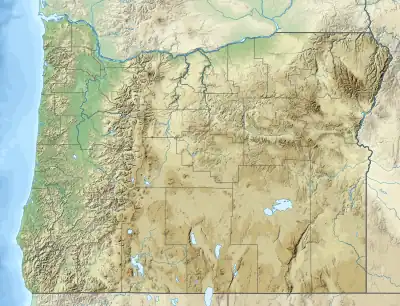| Alsea Formation | |
|---|---|
| Stratigraphic range: Rupelian (Whitneyan) ~ | |
| Type | Formation |
| Underlies | Yaquina Formation |
| Lithology | |
| Primary | Siltstone |
| Other | Mudstone |
| Location | |
| Coordinates | 44°36′N 124°00′W / 44.6°N 124.0°W |
| Approximate paleocoordinates | 44°18′N 113°06′W / 44.3°N 113.1°W |
| Region | Lincoln County, Oregon |
| Country | |
 Alsea Formation (the United States)  Alsea Formation (Oregon) | |
The Alsea Formation is a geologic formation in Oregon. It preserves fossils dating back to the Rupelian stage of the Oligocene period.[1]
Fossil content
The following fossils have been reported from the formation:[1]
Mammals
Fish
- Orthechinorhinus davidae[5]
See also
References
- 1 2 Alsea Formation at Fossilworks.org
- ↑ Deméré & Berta, 2008
- ↑ Peredo et al., 2018
- ↑ Fordyce, 2002
- ↑ Welton, 2016
Bibliography
- Peredo, C. M.; N. D. Pyenson; C. D. Marshall, and M. D. Uhen. 2018. Tooth loss precedes the origin of baleen in whales. Current Biology 28. 1-9. .
- Welton, B. J. 2016. First report of Orthechinorhinus (Squaliformes: Etmopteriidae) from the Pacific Basin; A new species from Early Oligocene rocks of Oregon, USA. Fossil Record 5. 303–308. .
- Deméré, T. A., and A. Berta. 2008. Skull anatomy of the Oligocene toothed mysticete Aetiocetus weltoni (Mammalia; Cetacea): implications for mysticete evolution and functional anatomy. Zoological Journal of the Linnean Society 154. 308–352. .
- Fordyce, R. E. 2002. Simocetus rayi (Odontoceti, Simocetidae, new family); a bizarre new archaic Oligocene dolphin from the eastern North Pacific. Smithsonian Contributions to Paleobiology 93. 185–222. .
This article is issued from Wikipedia. The text is licensed under Creative Commons - Attribution - Sharealike. Additional terms may apply for the media files.